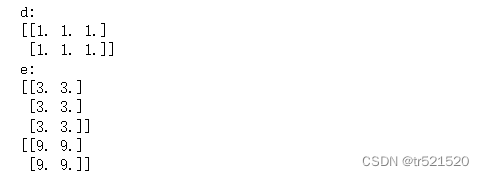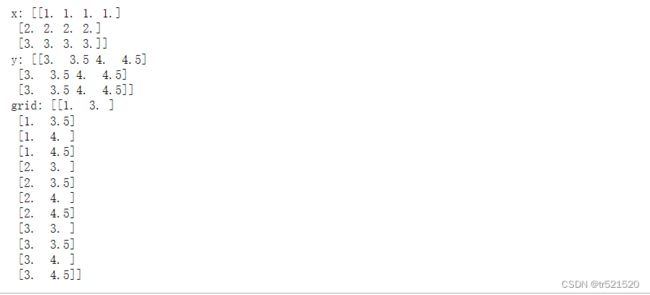张量的常用函数
默认已经导入tensorflow和numpy
1.计算
强制tensor转换为改数据类型
tf.cast(张量名, dtype=数据类型)
计算张量维度上元素的最小值
tf.reduce_min(张量名)
计算张量维度上元素的最大值
tf.reduce_max(张量名)
a1 = tf.constant([1,2,3],dtype=tf.float64)
print(a1)
a2 = tf.cast(a1,dtype=tf.int64)
print(a2)
print(tf.reduce_min(a2))
print(tf.reduce_max(a2))理解axis
在一个二维张量中axis=0表示对第一个维度进行操作,axis=1表示对第二个维度进行操作。
axis=0代表跨行,axis=1代表跨列,若不指定axis,所有元素均参与计算
比如,
计算张量沿着指定维度的平均值
tf.reduce_mean(张量名, axis=操作轴)
计算张量沿着指定维度的和
tf.reduce_sum(张量名,axis=操作轴)
b1 = tf.constant([[1,2,3],[2,3,4]])
print(b1)
b2 = tf.reduce_mean(b1, axis=0)
b3 = tf.reduce_mean(b1, axis=1)
b4 = tf.reduce_sum(b1)
with tf.Session() as sess:
print("横向mean:")
print(b2.eval())
print("纵向mean:")
print(b3.eval())
print("sum:")
print(b4.eval())2. tf.Variable
w = tf.Variable(初始值)
tr.Variable() 将变量标记为“可训练”,被标记的变量会在反向传播中记录梯度信息。神经网络训练中,常用该函数标记待训练参数。
w = tf.Variable(tf.random.normal([2,2],mean=0, stddev=1))3. 常用的运算:
四则:tf.add,tf.sbutract,tf.multiply,tf.divide
tf.add(张量1,张量2) tf.substract(张量1,张量2)
tf.multiply(张量1,张量2) tf.divide(张量1,张量2)
只有维度相同的张量才能做四则运算
a = tf.ones([1,3],dtype=tf.int32)
b = tf.fill([1,3],3)
with tf.Session() as sess:
print("a:")
print(a)
print("b:")
print(b)
sum_ab = tf.add(a,b).eval()
print(f"a+b的结果是{sum_ab}")
sub_ab = tf.subtract(a,b).eval()
mul_ab = tf.multiply(a,b).eval()
div_ab = tf.divide(a,b).eval()
print(f"a-b的结果是{sub_ab}")
print(f"a×b的结果是{mul_ab}")
print(f"a÷b的结果是{div_ab}")平方、次方与开方:tf.square,tf.pow,tf.sqrt
tf.square(张量名) tf.pow(张量名, n次方) tf.sqrt(张量名)
c = tf.fill([1,2],3.)
with tf.Session() as sess:
print("c:")
print(c.eval())
print(tf.square(c).eval())
print(tf.pow(c,3).eval())
print(tf.sqrt(c).eval())矩阵乘:tf.matmul
d = tf.ones([2,3])
e = tf.fill([3,2], 3.)
with tf.Session() as sess:
print("d:")
print(d.eval())
print("e:")
print(e.eval())
print(tf.matmul(d,e).eval())4. tf.data.Dataset.from_tensor_slices
切分传入张量的第一维度,生成输入特征/标签对,构建数据集
data = tf.data.Dataset.from_tensor_slices((输入特征,标签)) // Numpy和Tensor格式均可读入。
feature = tf.constant([1,3,5,7])
label = tf.constant([1,9,25,49])
dataset = tf.data.Dataset.from_tensor_slices((feature,label))5. tf.GradientTape
with 结构记录计算过程,gradient求出张量的梯度
with tf.GradientTape() as tape:
若干计算过程
grad = tape.gradient(函数,对谁求导)
with tf.GradientTape() as tape:
w = tf.Variable(tf.constant(3.0))
loss = tf.pow(w,2)
grad = tape.gradient(loss, w)
print(grad)![]()
如果报错了,在导入tensorflow包第二行加入tf.enable_eager_execution()
import tensorflow as tf
tf.enable_eager_execution()
import numpy as np
6. enumerate
enumerate是python内建函数,它可遍历每个元素(如列表、元组或者字符串),组合为索引 元素,常在for循环中使用。
enumerate(列表名)
seq = ["one", "two", "three"]
for i,element in enumerate(seq):
print(i,element)7. one-hot
one-hot编码:在分类问题中,常用one-hot编码做标签,标记类别:1表示是,0表示非。
tf.one_hot()函数啊将待转换数据,转换为one-hot形式的数据输出。
tf.one_hot(待转换数据,depth=几分类)
classes = 3
label = tf.constant([1,0,2])
output = tf.one_hot(label,depth=classes)
print(output)8. tf.nn.softmax
当n分类的n个输出时,通过softmax函数,便符合概率分布了。
y = tf.constant([1.01,2.01,-0.66])
y_pro = tf.nn.softmax(y)
print(y_pro)
![]()
9. assign_sub
赋值操作,更新参数的值并返回。调用assign_sub前,先用tf.Variable定义变量w为可训练(自更新)。
10. w.assign_sub(w要自减的内容)。
w = tf.Variable(4)
w.assign_sub(1)
print(w)即w = w-1,或者 w-=1
11. tf.argmax
返回张量沿指定维度最大的值的索引
tf.argmax(张量名,axis=操作轴)
test = np.array([[1,2,3],[2,3,4],[3,4,5],[5,6,7]])
print(test)
max_0 = tf.argmax(test,axis=0)
max_1 = tf.argmax(test,axis=1)
print(f"axis为0,max = {max_0}")
print(f"axis为1,max = {max_1}") 注意是最大值得索引。
tf.where
条件语句真返回A,条件语句假返回B
tf.where(条件语句,真返回A,假返回B)
a = tf.constant([1,2,3,1,4])
b = tf.constant([0,1,3,4,5])
c = tf.where(tf.greater(a,b), a,b)
print("c:",c)np.random.RandomState.rand
返回一个[0,1)之间的随机数
np.random.RandomState.rand(维度)
rrs = np.random.RandomState(seed=1)
a = rrs.rand() # 返回一个标量
b = rrs.rand(2,3) #返回一个矩阵np.vstack()
将两个数组按垂直方向叠加
np.vstack(数组1, 数组2)
a = np.array([1,2,3])
b = np.array([4,5,6])
c = np.vstack((a,b))
print("a:",a)
print("b:",b)
print("c:",c)np.mgrid[ ] .ravel( ) np.c_[ ]
np.mgrid[ ]
np.mgrid[ 起始值:结束值:步长,起始值:结束值:步长……] 左闭右开
x.ravel( ) 将x变为以为数组,“把 . 前变量拉直”
np.c_[ ] 使返回不的间隔数值点配对
np.c_[ 数组1,数组2,数组3 ……] 像保持一个第一个数组不动,另一个按照相应维度叠加上去
x, y = np.mgrid[1:4:1, 3:5:0.5]
print("x:",x)
print("y:",y)
grid = np.c_[x.ravel(),y.ravel()]
print("grid:",grid)










